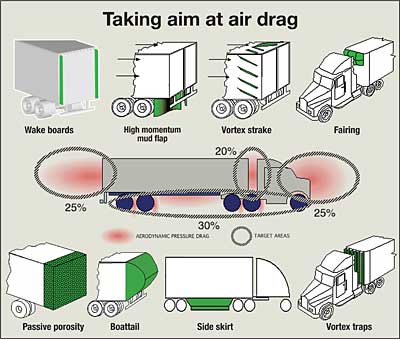 04-08-2016, 11:08 PM
04-08-2016, 11:08 PM
|
#1 (permalink)
|
|
Master EcoModder
Join Date: Jun 2009
Location: SC Lowcountry
Posts: 1,796
Thanks: 226
Thanked 1,354 Times in 711 Posts
|
Plasma drag reduction
.
Food for thought...
Freebeard mentioned plasma actuators in another thread. I recalled reading about the effect some time ago. Searching on the web for more info, I came across this.
Technology | Plasma Stream
Quote:
|
Our patented technology (s) uses an active flow control system utilizing plasma actuators has been developed at the University of Notre Dame. This system is capable of generating a body force which controls flow separation from a vehicle. By controlling flow separation, the drag force on a vehicle is minimized. In essence, a vehicle can be streamlined independent of its actual shape. Physical devices such as spoilers, bobtails, flow plates, and diverter tabs have been used to move the airflow in a desired direction. Plasma actuators ionize the local airflow to induce a similar affect without the added structural components or weight. Even the best designed physical devices attempt to divert flow, unlike plasmas which modify the existing flow field.
|
There are good videos in the link showing the effect.
Using plasma actuators to reduce drag in the future looks to be not only possible.
But, a glowing reality...

>
|
|
|

|
|
The Following 3 Users Say Thank You to redneck For This Useful Post:
|
|
 Today Today
|
|
|
|
 Other popular topics in this forum...
Other popular topics in this forum...
|
|
|
|
 04-08-2016, 11:45 PM
04-08-2016, 11:45 PM
|
#2 (permalink)
|
|
Master EcoModder
Join Date: Jan 2015
Location: Atlanta area
Posts: 410
Thanks: 966
Thanked 74 Times in 63 Posts
|
back to the future
|
|
|

|
 04-09-2016, 08:17 AM
04-09-2016, 08:17 AM
|
#4 (permalink)
|
|
Master EcoModder
Join Date: May 2011
Location: Syracuse, NY USA
Posts: 2,935
Thanks: 326
Thanked 1,315 Times in 968 Posts
|
The graphic in the link suposses a 15% reduction at the back of a truck box. Seems like it should be more. I wonder how much energy it takes to produce the plasma?
|
|
|

|
 04-09-2016, 12:34 PM
04-09-2016, 12:34 PM
|
#5 (permalink)
|
|
Master EcoModder
Join Date: Aug 2012
Location: northwest of normal
Posts: 29,344
Thanks: 8,347
Thanked 9,110 Times in 7,523 Posts
|


It take a high voltage, high frequency signal to open the plasma channel, but I think it takes less to maintain it. Could be wrong.
|
|
|

|
 04-09-2016, 09:38 PM
04-09-2016, 09:38 PM
|
#6 (permalink)
|
|
EcoModding Lurker
Join Date: Apr 2016
Location: Bettendorf
Posts: 2
Thanks: 0
Thanked 7 Times in 2 Posts
|
Power needed is very low. Our preliminary testing shows an average power consumption of 1 watt for 1 meter long actuator .
|
|
|

|
|
The Following 3 Users Say Thank You to PranayBajjuri For This Useful Post:
|
|
 04-09-2016, 09:52 PM
04-09-2016, 09:52 PM
|
#7 (permalink)
|
|
Master EcoModder
Join Date: Jun 2009
Location: SC Lowcountry
Posts: 1,796
Thanks: 226
Thanked 1,354 Times in 711 Posts
|
.
PranayBajjuri
Thanks for chiming in.
That is a very low power requirement.
It's always nice to have a representative or in this case "co founder" of the company to answer questions.
Any idea when it will be available...???
>
|
|
|

|
 04-09-2016, 10:17 PM
04-09-2016, 10:17 PM
|
#8 (permalink)
|
|
EcoModding Lurker
Join Date: Apr 2016
Location: Bettendorf
Posts: 2
Thanks: 0
Thanked 7 Times in 2 Posts
|
Preliminary on-truck testing is planned for August and planning to have a product for aft portion of the trailer (eTail) by early 2017.
|
|
|

|
|
The Following 4 Users Say Thank You to PranayBajjuri For This Useful Post:
|
|
 08-27-2016, 03:34 AM
08-27-2016, 03:34 AM
|
#9 (permalink)
|
|
Master EcoModder
Join Date: Aug 2012
Location: northwest of normal
Posts: 29,344
Thanks: 8,347
Thanked 9,110 Times in 7,523 Posts
|
As August is winding down, I wonder how the testing went.
Are things on track?
|
|
|

|
 08-27-2016, 08:32 AM
08-27-2016, 08:32 AM
|
#10 (permalink)
|
|
Master EcoModder
Join Date: Sep 2012
Location: Victoria, BC
Posts: 1,747
Thanks: 75
Thanked 577 Times in 426 Posts
|
Deflector shield on full; engage warp drive?
|
|
|

|
|
The Following 2 Users Say Thank You to Stubby79 For This Useful Post:
|
|
|